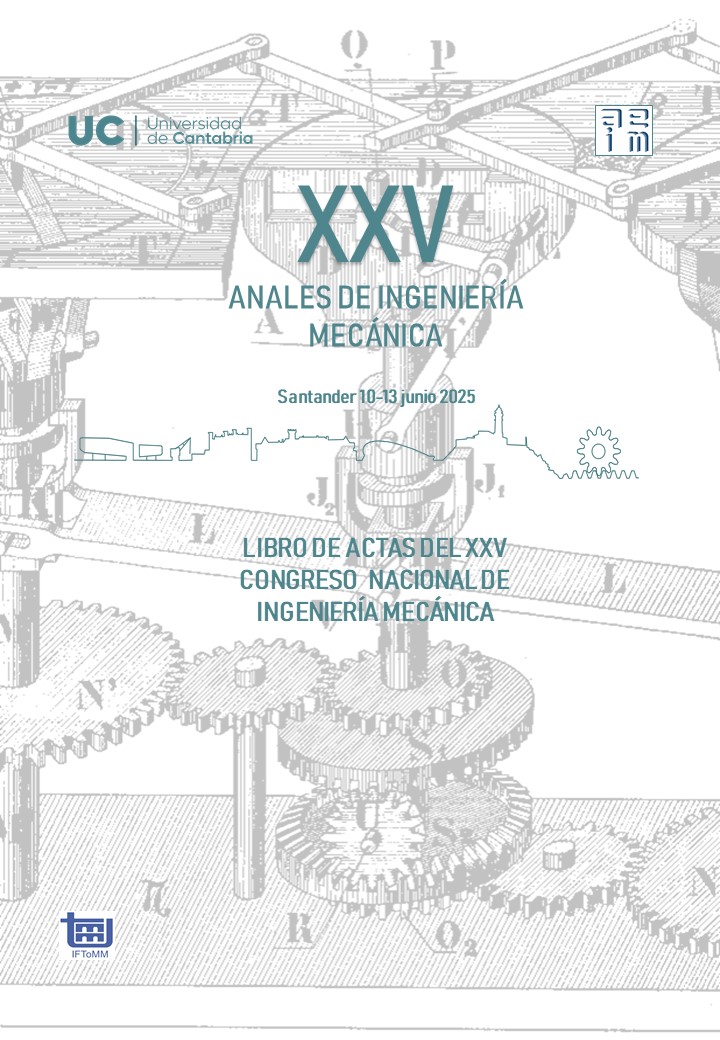Caracterización térmica del comportamiento piezoviscoso de un lubricante en un tribómetro
Contenido principal del artículo
Resumen
La correcta caracterización del coeficiente piezoviscoso de un lubricante en las condiciones de
presión y temperatura de trabajo de los contactos elastohidrodinámicos resulta muy compleja. Esto
se debe fundamentalmente a que los equipos experimentales actuales de medida directa de la
viscosidad son escasos y limitados para esas condiciones de trabajo tan extremas. Por otro lado, el
conocimiento del comportamiento del coeficiente piezoviscoso es comúnmente requerido en los
métodos precisos de cálculo analítico y numérico de transmisiones por engranajes, rodamientos,
levas… Por este motivo, resulta de gran interés científico y para la industria del lubricante, el
desarrollo de nuevas metodologías alternativas que permitan caracterizar los lubricantes bajo
condiciones tan extremas de trabajo.
Los autores de este trabajo ya han presentado con anterioridad una metodología simplificada para
la caracterización del coeficiente piezoviscoso, donde se emplean resultados experimentales
obtenidos en tribómetros de uso extendido en laboratorios con capacidad de medir el espesor de
película del lubricante (EHD) y el coeficiente de fricción del contacto (MTM). Estos resultados son
empleados en la resolución inversa de expresiones presentes en la literatura que permiten
caracterizar, a nivel teórico, el comportamiento del espesor de película y coeficiente de fricción de
los contactos elastohidrodinámicos, obteniendo finalmente el comportamiento del coeficiente
piezoviscoso del lubricante ensayado frente a la presión y la temperatura.
El objetivo de este artículo es presentar una metodología de cálculo que integra modelos más
precisos de los factores correctivos térmicos y de comportamiento no-newtoniano, que afectan al
cálculo teórico del espesor de película. También se comparan distintas expresiones analíticas para
la obtención de dichos factores y el espesor de película, quedándose con las que ofrecen mejores
resultados. La metodología es validada para una base sintética PAO-100.
Detalles del artículo

Esta obra está bajo una licencia internacional Creative Commons Atribución-NoComercial-CompartirIgual 4.0.
CC BY-NC-SA 4.0)
El lector puede compartir, copiar y redistribuir el material en cualquier medio o formato, siempre y cuando cumpla con las siguientes condiciones:
-
Atribución (BY): Debe dar crédito adecuado al autor original, proporcionando un enlace a la licencia y señalando si se han realizado cambios.
-
No Comercial (NC): No puede utilizar el material con fines comerciales. Esto significa que no puede venderlo ni obtener ganancias directas de su uso.
-
Compartir Igual (SA): Si adapta, transforma o construye sobre el material, debe distribuir sus contribuciones bajo la misma licencia que el original.
Recuerda que esta licencia no afecta los derechos legales del autor, como el derecho moral o las excepciones de uso justo.
Citas
Roelands C. J. A., Vlugter J. C., Waterman H. I.. “The Viscosity-Temperature-Pressure Relationship of
Lubricating Oils and Its Correlation With Chemical Constitution”, Journal of Basic Engineering, 85(4)
(1963)
Habchi W., Vergne P., Bair S., Andersson O., Eyheramendy D., Morales-Espejel G. E.. “Influence of pressure and temperature dependence of thermal properties of a lubricant on the behaviour of circular TEHD contacts”, Tribology International, 43(10) (2010)
Bair S., Mary C., Bouscharain N., Vergne P., “An improved Yasutomi correlation for viscosity at high
pressure”, Proceedings of the Institution of Mechanical Engineers, Part J: Journal of Engineering Tribology, 227(9) (2013)
Barus C., “Isothermals, isopiestics and isometrics relative to viscosity”, American Journal of Science, s3-45(266), 87–96 (1893)
Bair S., “The unresolved definition of the pressure-viscosity coefficient”, Nature. Scientific Reports, 12
(2022)
AGMA Standard 925-A03, “Effect Of Lubrication On Gear Surface Distress”, 2013.
Leeuwen H. van, “The determination of the pressure-viscosity coefficient of two traction oils using film thickness measurements”, Proceedings of the 6th International Conference on Continuously Variable and Hybrid Transmissions, 230-233, Maastricht The Netherlands (2010)
Leeuwen H. van, “The determination of the pressure-viscosity coefficient of a lubricant through an accurate film thickness formula and accurate film thickness measurements”, Proceedings of the Institution of Mechanical Engineers, Part J: Journal of Engineering Tribology, 223(8) (2009)
Leeuwen H. van, “The determination of the pressure-viscosity coefficient of a lubricant through an accurate film thickness formula and accurate film thickness measurements. Part 2: high L values”. Proceedings of the Institution of Mechanical Engineers, Part J: Journal of Engineering Tribology, 225(6) (2011)
Katyal P., Kumar P., “New central film thickness equation for shear thinning lubricants in elastohydrodynamic lubricated rolling/sliding point contact conditions”, ASME Journal of Tribology, 136: 1-9 (2014)
Chacón E. “Caracterización mediante tribómetro del comportamiento piezoviscoso de un lubricante”. Actas del XVI Congreso Iberoamericano de Ingeniería Mecánica, Concepción (2024)
Echávarri, J.; Lafont, P.; Chacón, E.; de la Guerra, E.; Díaz, A.; Munoz-Guijosa, J.M.; Muñoz, J.L.,
“Analytical model for predicting friction coefficient in point contacts with thermal elastohydrodynamic
lubrication”, Proc. IMechE, Part J: J. Eng. Tribol., 225, 181–191 (2011)
Bair S., “High pressure rheology for quantitative elastohydrodynamics”, Tribology and Interface
Engineering, 54, Elsevier (2007)
Hamrock B,J., “Fundamentals of fluid film lubrication”, McGraw-Hill, NewYork (1994)
Bair S., “Shear thinning correction for rolling/sliding elastohydrodynamic film thickness”, Proc IMechE, Part J: J Eng Tribol, 219, 69-74 (2005)
Katyal P., Kumar P., “Central film thickness formula for shear thinning lubricants in EHL point contacts under pure Rolling” , Tribology International, 48 (2012)
Bair S., “High Pressure Rheology for Quantitative Elastohydrodynamics”, Elsevier, Burlington (2007)
Kumar P., Khonsari M. M., “Traction in EHL Line Contacts Using Free-Volume Pressure-Viscosity
Relationship With Thermal and Shear-Thinning Effects”, Journal of Tribology, 131(1) (2009)
Larsson R., Andersson O., “Lubricant thermal conductivity and heat capacity under high pressure”. Proc IMechE, Part J: J Eng Tribol, 214(4):337–42 (2000)

